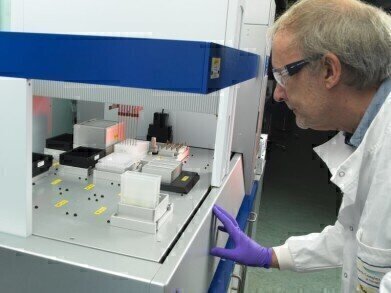-
 Professor Ray Owens, the leader of Protein Production UK.
Professor Ray Owens, the leader of Protein Production UK.
News & Views
Nanobodies Hold the Key to Imaging COVID-19
Apr 18 2020
Researchers from Protein Production UK, a collaborative project led by The Rosalind Franklin Institute, have isolated nanobodies - a type of antibody used in research - which bind to the ‘spike’ protein of the SARS-CoV-2 virus.
The team have already made these nanobodies, which bind with high affinity to the ‘spike’ protein, available to researchers at The University of Oxford. They will be making these important research tools widely available to other research groups around the world.
Nanobodies are antibodies found in camelids (llamas, alpacas and camels), which are much smaller than human antibodies. Their high stability, small structure, and specificity makes them ideal for the purification and stabilisation of proteins and protein structures, prior to imaging.
The team at The Franklin are targeting their work at a protein which sits on the outside of the SARS-CoV-2 viral particle known as the ‘spike’, which binds to human cells during an infection. This protein has a specific area - the receptor binding domain (RBD) - which is responsible for this binding action. The protein is a major target in COVID-19 research, as it plays a pivotal role in infection and may be a strong target for future vaccines and therapies.
Nanobodies can stabilise the ‘spike’ to enable better imaging at the atomic scale, using advanced imaging techniques including cryo-electron microscopy (cryo-EM). The nanobodies also enable the RBD to be stabilised bound to its target, helping researchers better understand how it behaves in the body, and how it might interact with new drugs.
The team are also investigating whether the nanobodies they identify, or therapies derived from them, could be used to create highly specific ‘blockers’, which could contribute to treatments for COVID-19, by preventing the SARS-CoV-2 virus from binding to human cells and causing infection. There is also potential in nanobodies for diagnostics, creating highly efficient and quick tests.
Professor James Naismith, Director of the Rosalind Franklin Institute explained: “One single protein often has multiple target sites (epitopes) for the human immune system to produce antibodies to bind to. When antibodies bind to certain epitopes they ‘neutralise’ the virus, this prevents further infection thus stopping the virus in its tracks. The tools that PPUK, a model for multi-partner collaborations, will make available will be helpful to scientists working on SARS-CoV-2 virus.”
Identifying which nanobodies have ‘binding’ and which have ‘binding and neutralising’ actions is a key next step for the group, and one which will see them search for a wider range of nanobodies, and compare their action to human antibodies derived from patient samples.
Professor Ray Owens, who leads Protein Production UK for The Franklin, said: “There is an unprecedented level of team-work and collaboration globally to image, understand, and treat COVID-19. We are working with colleagues at the University of Oxford to use the nanobodies developed here at The Franklin, to gain insights into the structure of the virus that causes COVID -19.”
More information online
Digital Edition
Lab Asia 31.2 April 2024
April 2024
In This Edition Chromatography Articles - Approaches to troubleshooting an SPE method for the analysis of oligonucleotides (pt i) - High-precision liquid flow processes demand full fluidic c...
View all digital editions
Events
Apr 28 2024 Montreal, Quebec, Canada
May 05 2024 Seville, Spain
InformEx Zone at CPhl North America
May 07 2024 Pennsylvania, PA, USA
May 14 2024 Oklahoma City, OK, USA
May 15 2024 Birmingham, UK

















